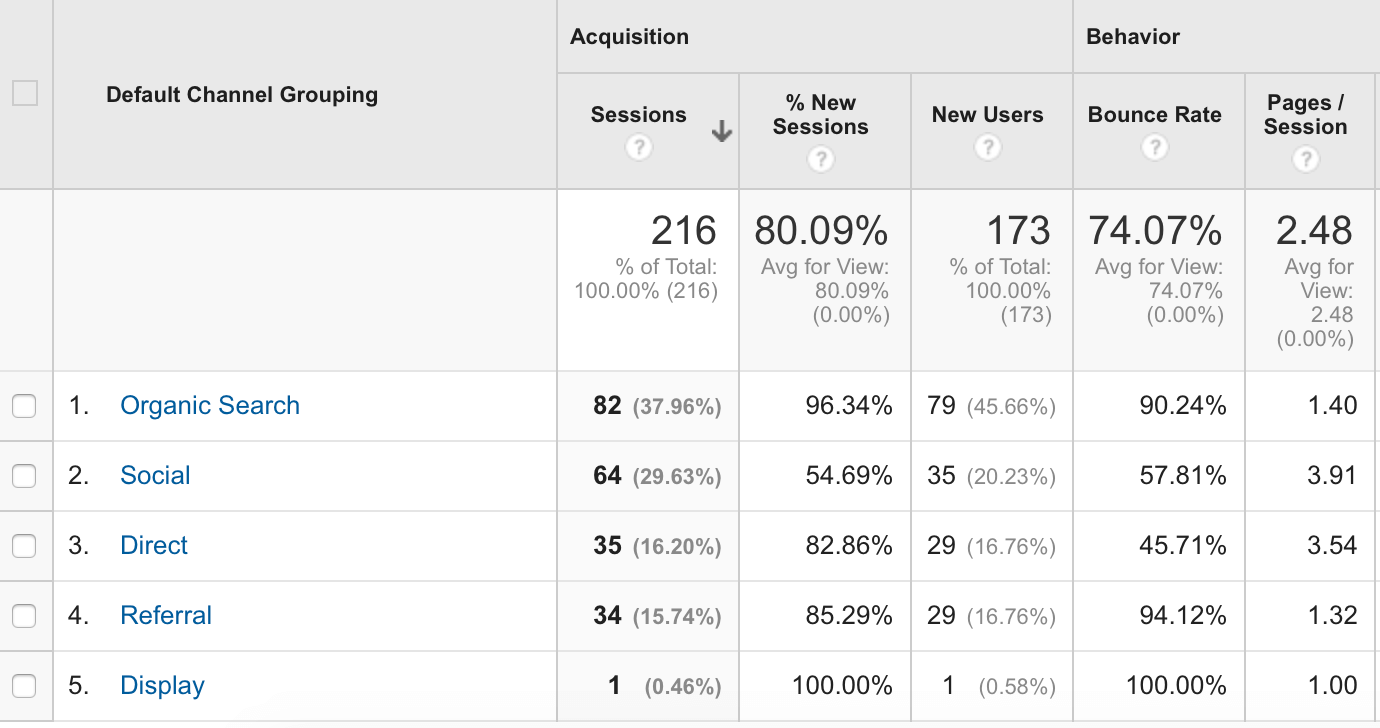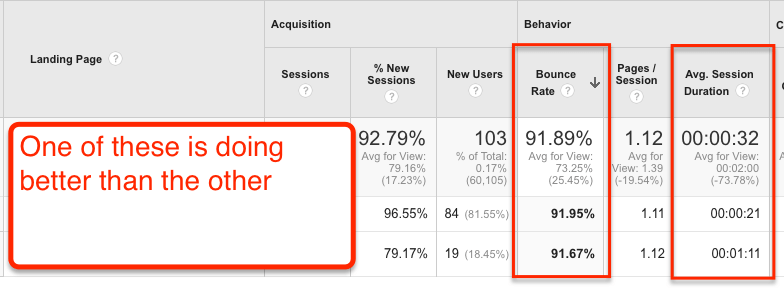Bounce rate can be a great metric when evaluating how people interact with your overall website and individual pages. Yet, it’s one of the more mystifying metrics in analytics, mainly because there are a ton of misconceptions about what bounce rate actually is and what it means.
To provide some clarity, I’ll be diving into what bounce rate is, what it isn’t, and some proper ways to look at the metric in order to garner real insights about your site.
What is Bounce Rate?
According to Google Analytics, bounce rate is defined as the percentage of “single-page sessions”. What this really means is, it’s the number of people who land on a page of your site… and then immediately leave.
Bounce rate calculated by dividing the total number of visits viewing one page only by the total entries to that page.
In Google Analytics, this appears as a percentages. So, for example, if you see a bounce rate of 45% for your home page, that means 45% of the people who visit your homepage leave immediately without interacting with the page (AKA, clicking through to another page on the site).
There are a few ways to find your bounce rate.
First, you can look at the “Behavior” section of Google Analytics.
Under the “Site Content” tab, click “All Pages” to see a breakdown of the bounce rate on a page by page basis. This view will also show you pageviews and average time on page, which you can use to give context to the bounce rate (more on that in a minute).

You can also find bounce rate in the “Acquisition” section of Google Analytics. Click “All Traffic” and then “Channels”, “Source/Medium”, or “Referrals”. All of these views will show you bounce rate within the context of different types of traffic.

People look at bounce rate for a lot reasons, and not all of them are actually accurate.
However, the primary reason people look at a bounce rate is to determine if a website (or landing page, or e-commerce page) is retaining customers.
It’s a great way to tell if people are taking the actions you want them to take, or if they’re simply hitting your page and dipping out because there’s nothing there to hold them.
Bounce Rate Misconceptions
There are a ton of bounce rate misconceptions out there, and they all stem from the fact that bounce rate means nothing without context.
On its own, it’s just a number.
Bounce rate doesn’t really tell you anything about consumer behavior until you look at other relative metrics and your goals for individual pages. Let’s take a look at a few typical misconceptions to see how this works:
Misconception #1: A high bounce rate is bad
People tend to think that a high bounce rate is a bad thing. After all, doesn’t that mean they visited your page and then left?!
Well, yes.
But that doesn’t necessarily mean your page didn’t complete its goal. Say the page in question is actually a broad blog post you wrote that you want people to share.
If someone read the post, shared it on social, and then left, they technically still “bounced”, as that share isn’t counted as an interaction. However, what happened wasn’t bad. It was actually good!
The blog post was supposed to be read and shared, and that’s exactly what happened.
Misconception #2: A low bounce rate is good
On the flip side of the whole “high bad bounce rate = bad” equation is the misconception that a low bounce rate is always a good thing.
Not so.
What if someone lands on a product page, where ideally you’d like them to convert, but instead they start browsing a bunch of irrelevant pages, which distracts them from actually purchasing said product.
This would show a low bounce rate, but in this case, would mean that your product page is failing.
Misconception #3: You need a target bounce rate
When you research bounce rate, you’ll come across a lot of resources that say you bounce rate should be a certain percentage.
In reality, a bounce rate is 100% relative to your goals and immediate context (like other metrics).
So, if another blog has a bounce rate of 85% on individual posts, that doesn’t mean I should have a bounce rate of 85% on my posts.
Bounce rate isn’t something that can be compared across competitors or even other websites, which means a “target” bounce rate doesn’t actually exist.
Misconception #4: Bounce rate doesn’t matter
After seeing all of the different ways bounce rate gets misconstrued, it’s easy to just throw it in the trash as a metric, right?
Wrong!
Despite the misconceptions, bounce rate is still a metric you should be looking at on a regular basis.
How else are you going to understand how people react to your site if you don’t look at whether or not they are taking the actions you want them to?
How to Use Bounce Rate
Now that we’ve gotten the misconceptions out of the way, let’s talk about a few correct ways you can use bounce rate to evaluate your site performance.
Bounce Rate + [metric]
To put some context around bounce rate, considering pairing it with another metric, such as average time on site or traffic source.
For example, if you want to see how people are engaging with a blog post, look at the bounce rate and average time on site.
If the bounce rate is high, but the average time on page is also high, you can deduce that visitors are most likely reading your post all the way through before leaving the page, indicating a successful topic.

You can also compare bounce rates across various traffic sources to see how different sources react.
For example, if you notice your paid traffic tends bounce from an ecommerce page more than your organic traffic, then perhaps you need to reevaluate the ads that send visitors to those pages — perhaps they aren’t clearly communicating expectations, which is causing visitors who get to that page via a paid ad to leave immediately since it isn’t the information they were looking for.

Bounce Rate + Goal
Another way to contextualize bounce rate is by evaluating the metric based on goals you have for individual pages. For example, say you have an ecommerce category page, like this one from REI.

You would expect the bounce rate to be low, because this page is used for navigational purposes. You want people to click through to the individual product page, which means people are interacting with the page instead of “bouncing”.
However, when you compare that to a blog post page (like this one), you’d expect to see a higher bounce rate, because the purpose isn’t navigational.
For a post like this, I want you to come to this page, find the answers to your questions about bounce rate, and then share it with your friends. Those actions aren’t considered “interactions” in the bounce rate calculations, so a high bounce rate here is actually fine.
Changes in Bounce Rate
Another great way to look at bounce rate is by looking for drastic changes in the rate, especially after you make changes to your site or certain pages. For example, say you redo your site design.
Suddenly, you notice that your ecommerce category pages have a much higher bounce rate. It’s probably safe to deduce that these two are correlated, right?
The new design is negatively affecting interactions with that navigational product category page, which is causing people to leave instead of drill down to the product pages.
You can also evaluate changes in bounce rate after you add new features to pages, like pop-ups. If your pop-up is a irrelevant advertisement, chances are people won’t ex-out, they’ll simply bounce out.
Keep an eye on any fluctuations in bounce rate once you’ve added new features or functionality to make sure visitors are still finding the information they need and interacting with the pages as you intended.
Next Steps
Now that you know how to properly evaluate bounce rate, it’s time to put it into action. To get started, make sure you define goals for your site AND individual pages first. You need to know what you’re actually measuring before you starting thinking of bounce rate in terms of “good” and “bad”.
Then, determine your thresholds. You shouldn’t have a “target” bounce rate, but you should be looking for trends or anything out of the ordinary, especially after you make changes to your site or individual pages.
Lastly, use your analytics to solve specific problems. Always remember that bounce rate isn’t something to look at in isolation. Combine it with different metrics in Google Analytics (like traffic sources or time on page) to diagnose issues and implement changes.




Bounce rate factor has confused many seo professionals and people. If you are looking for some useful information on bounce rate then you should visit this excellent blog post: http://socialmediatoday.com/baawraman/1070231/bounce-rate-and-seo